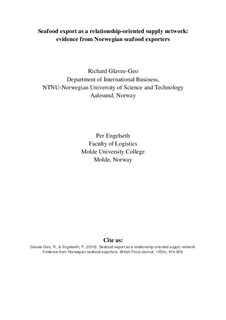| dc.contributor.author | Glavee-Geo, Richard | |
| dc.contributor.author | Engelseth, Per | |
| dc.date.accessioned | 2018-10-09T12:13:09Z | |
| dc.date.available | 2018-10-09T12:13:09Z | |
| dc.date.created | 2018-03-08T13:00:09Z | |
| dc.date.issued | 2018 | |
| dc.identifier.citation | British Food Journal. 2018, 120 (4), 914-929. | nb_NO |
| dc.identifier.issn | 0007-070X | |
| dc.identifier.uri | http://hdl.handle.net/11250/2567135 | |
| dc.description.abstract | Purpose: The purpose of this paper is to examine the role of relationships and networking in the international flow of seafood products through export processes and practices using empirical case examples. Design/methodology/approach: This paper provides an insight into seafood export through 10 case studies of seafood exporters from Norway and a freight forwarder working with most of these companies. Findings: The international seafood business is characterised by coordination, interactions and exchange such that economic and social interactions among network members transcend national boundaries into international/global markets. Findings reveal how studied seafood exports are in line with the learning-based Uppsala internationalisation model, embedded in international buyer-seller relationship structures and networks, which is also a particularity of this food-producing industry. To secure long-term business in distant markets, small and medium-sized (SME) seafood exporters have shifted the focus from transactional approaches to relationships and networking as a means of improving export performance. This paper suggests how logistics and marketing have become closely and strategically interconnected, and so marketing strategies depend on logistics strategies and the two cannot be separated in a typical global seafood supply network. Practical implications: Purposeful collaborative interaction between exporter and importer helps in risk mitigation. Increased interactions in distant markets by SMEs can also be achieved using social media networking. Originality/value: This paper offers an insight into the global seafood supply network using empirical case examples from Norway, an important seafood producing country. | nb_NO |
| dc.language.iso | eng | nb_NO |
| dc.publisher | Emerald | nb_NO |
| dc.title | Seafood export as a relationship-oriented supply network: evidence from Norwegian seafood exporters | nb_NO |
| dc.title.alternative | Seafood export as a relationship-oriented supply network : evidence from Norwegian seafood exporters | nb_NO |
| dc.type | Journal article | nb_NO |
| dc.type | Peer reviewed | nb_NO |
| dc.description.version | acceptedVersion | nb_NO |
| dc.source.pagenumber | 914-929 | nb_NO |
| dc.source.volume | 120 | nb_NO |
| dc.source.journal | British Food Journal | nb_NO |
| dc.source.issue | 4 | nb_NO |
| dc.identifier.doi | 10.1108/BFJ-04-2017-0249 | |
| dc.identifier.cristin | 1571437 | |
| dc.description.localcode | © 2018. This is the authors' accepted and refereed manuscript to the article. The final authenticated version is available online at: https://doi.org/10.1108/BFJ-04-2017-0249 | nb_NO |
| cristin.unitcode | 194,60,15,0 | |
| cristin.unitname | Institutt for internasjonal forretningsdrift | |
| cristin.ispublished | true | |
| cristin.fulltext | postprint | |
| cristin.qualitycode | 1 | |
